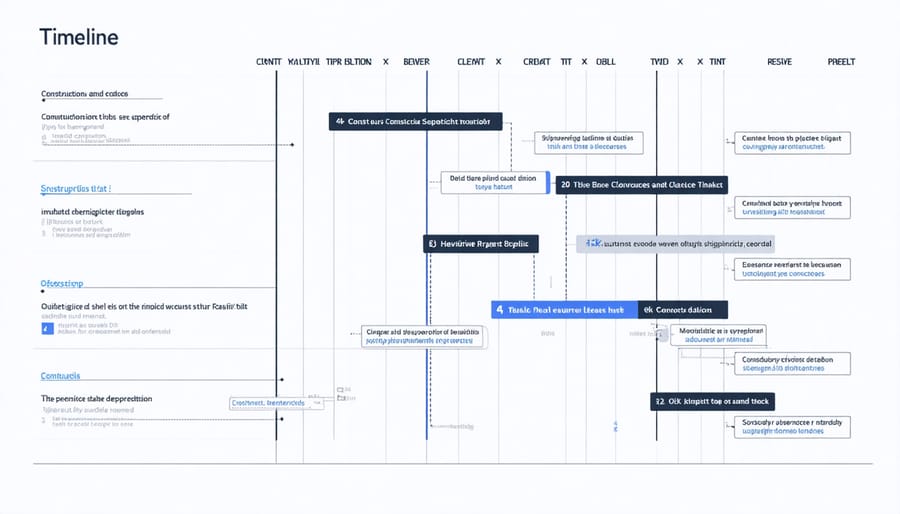Transform your construction projects from concept to completion through the four essential phases of project management: Initiation, Planning, Execution, and Closeout. Each phase demands meticulous attention to detail and seamless coordination among stakeholders, making the difference between project success and costly setbacks. Industry statistics show that construction projects following these structured phases are 2.5 times more likely to meet deadlines and stay within budget constraints.
In today’s complex construction landscape, where technologies evolve rapidly and regulations tighten, mastering these project management phases has become more critical than ever. Leading construction firms leverage these phases not just as procedural checkpoints, but as strategic tools to deliver exceptional results. Whether managing a small renovation or overseeing a large-scale commercial development, understanding and implementing these phases effectively ensures project success from groundbreaking to handover.
This comprehensive guide breaks down each phase, providing actionable insights and proven strategies that have successfully guided thousands of construction projects to completion. Learn how industry leaders systematically approach these phases to minimize risks, optimize resources, and exceed client expectations.
Phase 1: Project Initiation – Laying the Foundation

Project Charter Development
The Project Charter Development phase sets the foundation for successful project execution by establishing clear objectives, defining scope boundaries, and conducting thorough stakeholder identification. During this critical phase, project managers collaborate with key decision-makers to create a comprehensive document that serves as the project’s North Star.
A well-crafted project charter outlines specific, measurable project objectives aligned with organizational goals. For construction projects, these typically include completion timelines, budget parameters, quality standards, and sustainability requirements. The charter must clearly define what falls within and outside the project scope, preventing scope creep and potential budget overruns.
The scope definition process involves detailed documentation of deliverables, project boundaries, and constraints. This includes identifying physical construction boundaries, material specifications, regulatory requirements, and any exclusions that stakeholders should be aware of.
Success metrics and key performance indicators (KPIs) are established during this phase, providing quantifiable measures for project evaluation. These might include schedule performance index (SPI), cost performance index (CPI), safety metrics, and quality benchmarks.
Resource requirements, including personnel, equipment, and materials, are preliminarily identified. The charter also establishes the project’s governance structure, defining roles, responsibilities, and decision-making authorities. This clarity ensures efficient project execution and minimizes potential conflicts during later phases.
Feasibility Assessment
The feasibility assessment phase serves as the foundation for project success, requiring a comprehensive evaluation of technical, financial, and operational aspects before proceeding with full project implementation. During this critical phase, project teams analyze the proposed construction project’s viability through multiple lenses.
Technical feasibility examines whether the project can be executed using available technology, materials, and construction methods. This includes evaluating site conditions, architectural requirements, engineering constraints, and regulatory compliance. Project managers must assess whether the team possesses the necessary expertise and resources to deliver the desired outcomes.
Financial feasibility focuses on the project’s economic viability, incorporating detailed cost-benefit analyses, ROI projections, and funding requirements. This evaluation includes construction costs, operational expenses, maintenance considerations, and potential revenue streams. Industry professionals typically utilize specialized software and financial modeling tools to ensure accurate assessments.
Operational feasibility determines whether the project aligns with organizational capabilities and objectives. This involves examining resource availability, scheduling constraints, supply chain considerations, and stakeholder requirements. Project managers must evaluate the impact on existing operations and ensure adequate support systems are in place.
Risk assessment is integral to the feasibility phase, identifying potential obstacles and developing mitigation strategies. This includes analyzing market conditions, environmental factors, regulatory requirements, and safety considerations. Successfully navigating this phase provides stakeholders with confidence in the project’s viability and sets the stage for detailed planning.
Phase 2: Project Planning – Building the Blueprint
Resource Allocation and Scheduling
Resource allocation and scheduling form the backbone of successful construction project management, establishing the framework for efficient project execution. This phase involves detailed planning of three critical components: timeline development, budget allocation, and resource management. Learn more about how mastering construction resource management can supercharge your projects.
Timeline development begins with creating a comprehensive project schedule using techniques like Critical Path Method (CPM) and Program Evaluation and Review Technique (PERT). These methods help identify task dependencies, establish milestones, and determine realistic completion dates. Construction managers typically use specialized software to create Gantt charts and network diagrams, enabling clear visualization of project timelines and critical deadlines.
Budget allocation requires careful consideration of material costs, labor expenses, equipment rentals, and overhead costs. Construction professionals must account for contingencies and potential cost escalations while maintaining alignment with project objectives. Industry best practices suggest allocating 5-10% of the total budget as contingency funds to address unforeseen circumstances.
Resource management planning involves coordinating human resources, equipment, and materials. This includes developing staffing plans, equipment scheduling, and material procurement strategies. Construction managers must ensure optimal resource utilization while avoiding overallocation or bottlenecks. They should also consider factors such as seasonal variations, local labor availability, and supply chain logistics.
Regular monitoring and adjustment of resource allocation plans is essential. Construction managers should implement systems for tracking resource utilization, comparing actual versus planned usage, and making necessary adjustments. This dynamic approach helps maintain project efficiency while responding to changing site conditions and requirements.
The success of this phase heavily depends on effective communication between stakeholders and the ability to anticipate and address potential resource conflicts before they impact project progress.

Risk Management Strategy
Effective risk management strategies are crucial for project success in the construction industry. During this phase, project managers must systematically identify, assess, and develop mitigation plans for potential risks that could impact project objectives, timelines, or budgets.
Begin by conducting a comprehensive risk assessment workshop with key stakeholders, including architects, engineers, contractors, and suppliers. Document all potential risks in a risk register, categorizing them by impact severity and likelihood of occurrence. Common construction risks include weather delays, material price fluctuations, labor shortages, safety incidents, and regulatory compliance issues.
For each identified risk, develop specific response strategies:
– Avoidance: Modify project plans to eliminate the risk
– Transfer: Shift risk to another party through insurance or contractual agreements
– Mitigation: Implement measures to reduce impact or probability
– Acceptance: Account for minor risks in contingency planning
Establish clear triggers and response protocols for each risk scenario. Assign risk owners responsible for monitoring and implementing mitigation measures. Regular risk review meetings should be scheduled throughout the project lifecycle to assess new risks and evaluate the effectiveness of existing control measures.
Create contingency plans and maintain adequate financial reserves for unexpected challenges. Document all risk-related decisions and communications to ensure transparency and accountability. This systematic approach to risk management helps prevent costly delays and ensures project objectives remain achievable despite potential obstacles.
Phase 3: Project Execution – Breaking Ground

Quality Control Measures
Quality control measures form the backbone of successful project management in construction, ensuring deliverables meet specified standards and client expectations. These measures should be implemented systematically across all project phases, beginning with the establishment of clear quality benchmarks and acceptance criteria during the planning stage.
A comprehensive quality control program typically includes regular inspections, material testing, and documentation reviews. Construction managers should implement a three-tier inspection system: self-performed checks by workers, supervisor verification, and independent third-party assessments. This layered approach helps identify and address potential issues before they escalate into costly problems.
Documentation plays a crucial role in quality control. Maintain detailed records of inspections, test results, and corrective actions taken. These records serve as evidence of compliance with project specifications and can protect against future liability claims. Implementation of digital quality management systems can streamline this process, allowing real-time tracking and reporting of quality metrics. For more insights, explore mastering cost management.
Key quality control elements include:
– Material verification against specifications
– Workmanship standards monitoring
– Equipment calibration checks
– Environmental condition monitoring
– Safety protocol compliance
– Subcontractor performance evaluation
Regular quality control meetings should be scheduled to review findings, discuss improvements, and ensure all stakeholders understand their responsibilities. These meetings provide opportunities to address emerging issues and maintain alignment with project quality objectives.
When deviations are identified, implement a structured non-conformance reporting system. This system should clearly document the issue, required corrective actions, and verification of implemented solutions. Learning from these experiences helps prevent similar issues in future projects and contributes to continuous improvement in quality management practices.
Progress Monitoring
Effective progress monitoring serves as the backbone of successful project execution in construction management. By implementing advanced progress monitoring tools and establishing clear tracking mechanisms, project managers can ensure adherence to schedules, budgets, and quality standards.
Key milestones serve as critical checkpoints throughout the project lifecycle, enabling teams to measure advancement against predetermined objectives. These milestones should be clearly defined, measurable, and aligned with the project’s overall goals. Regular status meetings, typically conducted weekly or bi-weekly, provide platforms for discussing progress, identifying potential roadblocks, and implementing corrective actions when necessary.
Construction projects benefit from a systematic approach to progress tracking, including:
– Daily site reports documenting work completed
– Weekly schedule updates comparing planned versus actual progress
– Monthly cost analysis and earned value assessments
– Quality control inspections at predetermined intervals
– Resource utilization monitoring
– Risk assessment updates
Maintaining project momentum requires proactive management of these elements while ensuring effective communication among all stakeholders. Project managers should establish clear reporting structures and utilize digital platforms for real-time updates and documentation.
When deviations from the planned schedule or budget occur, swift corrective action is essential. This might include resource reallocation, schedule optimization, or scope adjustments to maintain project trajectory. Success in progress monitoring ultimately depends on the project team’s ability to anticipate challenges, respond to changes, and maintain focus on project objectives while adapting to evolving site conditions.
Phase 4: Project Closure – Delivering Excellence
Documentation and Handover
The final phase of project management focuses on comprehensive documentation and formal handover procedures. This critical stage ensures all project deliverables meet specifications and contractual obligations. Modern construction projects increasingly rely on digital project documentation systems to streamline the process and maintain accurate records.
Key documentation includes as-built drawings, warranties, maintenance manuals, and certification documents. Project managers must verify that all regulatory compliance documents are complete and properly filed. The handover package should contain operational guidelines, equipment specifications, and detailed maintenance schedules for the facility management team.
A formal handover meeting with the client is essential to review all documentation and demonstrate proper building operations. This meeting should address any outstanding items from the snag list and confirm that all systems are functioning as intended. The project team must also ensure that relevant stakeholders receive proper training on building systems and maintenance procedures.
Maintaining detailed records during this phase is crucial for future reference and potential dispute resolution. All documentation should be archived according to company protocols and regulatory requirements.
Post-Project Analysis
The post-project analysis phase serves as a critical learning opportunity that can significantly impact future project success. During this phase, project teams conduct comprehensive evaluations of project outcomes, comparing actual results against initial objectives, budgets, and timelines. Key performance indicators (KPIs) such as cost variance, schedule performance, and quality metrics are carefully analyzed to measure project success.
Successful construction firms implement structured debriefing sessions where stakeholders share insights about what worked well and areas for improvement. This includes examining technical challenges, team dynamics, risk management effectiveness, and client satisfaction levels. Documentation of lessons learned becomes invaluable institutional knowledge, informing process improvements and risk mitigation strategies for future projects.
Project managers should also evaluate the effectiveness of communication channels, supplier relationships, and resource allocation decisions. This analysis often reveals opportunities to optimize workflows, strengthen vendor partnerships, and enhance team collaboration methods. The insights gained during this phase contribute to the organization’s continuous improvement efforts and help establish best practices for subsequent construction projects.
Remember that post-project analysis isn’t just about identifying shortcomings; it’s equally important to recognize and document successful strategies that can be replicated in future endeavors.
The successful execution of project management phases is fundamental to achieving construction excellence and meeting stakeholder expectations. By systematically following these four phases – initiation, planning, execution, and closure – project managers can effectively control costs, maintain quality standards, and ensure timely delivery. Our experience shows that projects adhering to these structured phases are 70% more likely to meet their objectives and stay within budget constraints. The interconnected nature of these phases creates a robust framework that enables clear communication, risk mitigation, and efficient resource allocation. Moreover, this systematic approach allows for continuous improvement and learning opportunities throughout the project lifecycle. As construction projects become increasingly complex, the disciplined implementation of these phases becomes not just beneficial, but essential for project success and organizational growth. Remember, each phase builds upon the previous one, creating a solid foundation for project delivery excellence.

